Physical Address
304 North Cardinal St.
Dorchester Center, MA 02124
Since the late 1990s advances in imaging technology, including digital subtraction chest radiographs, multidetector spiral computed tomography (MDCT), dual-energy computed tomography (CT) techniques, electrocardiograph (ECG)-gated CT, positron emission tomography (PET) with CT, and magnetic resonance imaging (MRI), have improved diagnostic accuracy and management of patients with thoracic abnormalities. The electronic distribution of these studies as digital images via a picture archiving and communication system, has also expedited information transfer and interpretation.
This chapter is a general overview of the advances in thoracic imaging, with a focus on imaging modalities used for the evaluation of the surgical patient. Topics reviewed include a spectrum of mediastinal, lung, pleural, and chest wall abnormalities commonly encountered by thoracic surgeons in which imaging is important in the diagnosis and management of patients.
Mediastinal abnormalities have a variety of causes, including congenital malformations, infections, trauma, and neoplasms. Clinical history and prior radiographs are often sufficient to determine the cause and the necessity for further evaluation. In the absence of prior imaging studies, chest radiographs, CT, or MRI are most commonly used to establish a diagnosis or to provide a differential diagnosis.
Multidetector computed tomography, dual-energy CT, and ECG-gated CT together with sophisticated post-processing methods have transformed imaging of the thoracic aorta. More recently, rapidly acquired (single breath-hold) non–ECG-gated CT imaging has become available and is being used as the initial diagnostic imaging modality to evaluate patients with suspected acute aortic dissection. Furthermore, because single-acquisition dual-source CT with the availability of low- and high-kVp data acquired from the same volume eliminates aortic precontrast imaging, reduces radiation exposure, and uniquely characterizes aortic pathology, it is being recommended in the initial evaluation of the aorta.
Acute aortic syndrome is the term currently used to refer to a group of potentially life-threatening disorders of the thoracic aorta including aortic dissection, intramural hematoma (IMH), and penetrating atheromatous ulcer (PAU). The most common presenting complaint in patients with acute aortic syndrome is acute onset of severe chest pain, but symptoms can be nonspecific and variable. Aortic dissection is the most common acute aortic disorder, and IMH and PAU account for 10% to 20% of acute aortic syndrome cases. Two different mechanisms leading to the characteristic intimal tear in aortic dissection have been proposed and remain debatable: primary disruption of the intima versus secondary rupture of a hematoma arising from the vasa vasorum.
MDCT with intravenous contrast is the imaging modality of choice when an aortic dissection is suspected, and it can determine the type and extent of the dissection for management decisions. The DeBakey and Stanford classifications are widely recognized and both based on the origin of the intimal tear and the extent of the aortic involvement. Stanford Type A dissection involves the ascending aorta and originates just above the aortic valve plane; it is usually considered for surgical repair. Stanford Type B dissection originates just below the level of the ligamentum arteriosum, and it is generally managed medically. Endovascular or surgical interventions are indicated for patients who develop complications from Stanford Type B dissections ( Fig. 2-1 ).
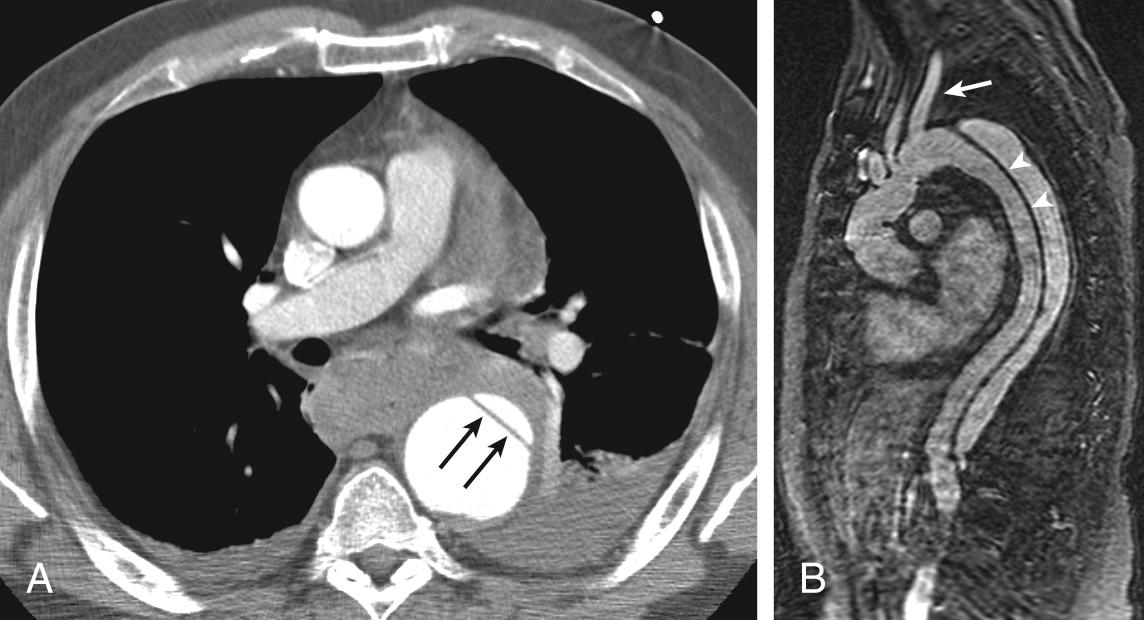
The primary diagnostic finding on CT is an intimal flap separating the true from the false lumen. The sensitivity and specificity approaches 100%, with an accuracy that is superior to that of angiography. Images are usually viewed as two-dimensional orthogonal axial sections, combined with volume-rendering and multiplanar reconstruction images. However, these techniques are unable to depict the dissection wall as a whole. To overcome this limitation, an automatic segmentation and three-dimensional visualization of the dissection wall has been proposed to isolate the dissection (or flap) from the rest of the vascular structures and improve diagnosis and characterization of the dissection. When iodinated contrast agents are contraindicated, MRI or transesophageal echocardiography can be used to diagnose and determine the type of dissection. Although these imaging modalities are accurate, both have limitations in large patients, and the ability to perform these studies in the acute setting is not optimal.
Patients with thoracic trauma usually require imaging evaluation, and the type of study depends on the mechanism of injury and the structures potentially involved. From an imaging perspective, the chest radiograph is typically the first study performed and often dictates whether additional imaging is warranted. The radiographic findings suggestive of traumatic aortic injury (TAI) are an indistinct aortic arch or descending aorta, a left apical cap, tracheal displacement to the right, displacement of the nasogastric tube to the right of the T4 spinous process, mediastinal widening, and inferior displacement of the left main-stem bronchus ( Fig. 2-2 ). Less specific findings include a left pleural effusion and widening of the paravertebral stripe. These features, however, are only suggestive, not indicative, of an aortic injury. In contrast, the negative predictive value of a normal chest radiograph for an aortic injury is 94% to 96%. If there is a chest radiographic abnormality, MDCT is the primary imaging method for the diagnosis of TAI. The sensitivity for this technique is 100%, and the specificity ranges from 83% to 99.7% ( Fig. 2-3 ). In fact, MDCT has superseded aortography in the diagnosis of TAI and vascular injuries and selective aortography is now reserved for therapeutic catheter-based endovascular interventions. Direct signs for TAI include a linear intraluminal filling defect, pseudoaneurysm formation, an abrupt caliber change, and contrast extravasation. Indirect signs of TAI, most notably a periaortic hematoma, are found in 91% of patients with surgically proven TAI. The absence of a periaortic abnormality and a normal-appearing aorta on MDCT has a negative predictive value of 100%. Additional nonvascular thoracic injuries can be found in 7% of patients who do not have an aortic transection on MDCT. Such abnormalities are usually a combination of pneumothoraces, multiple rib fractures, and pulmonary contusions.
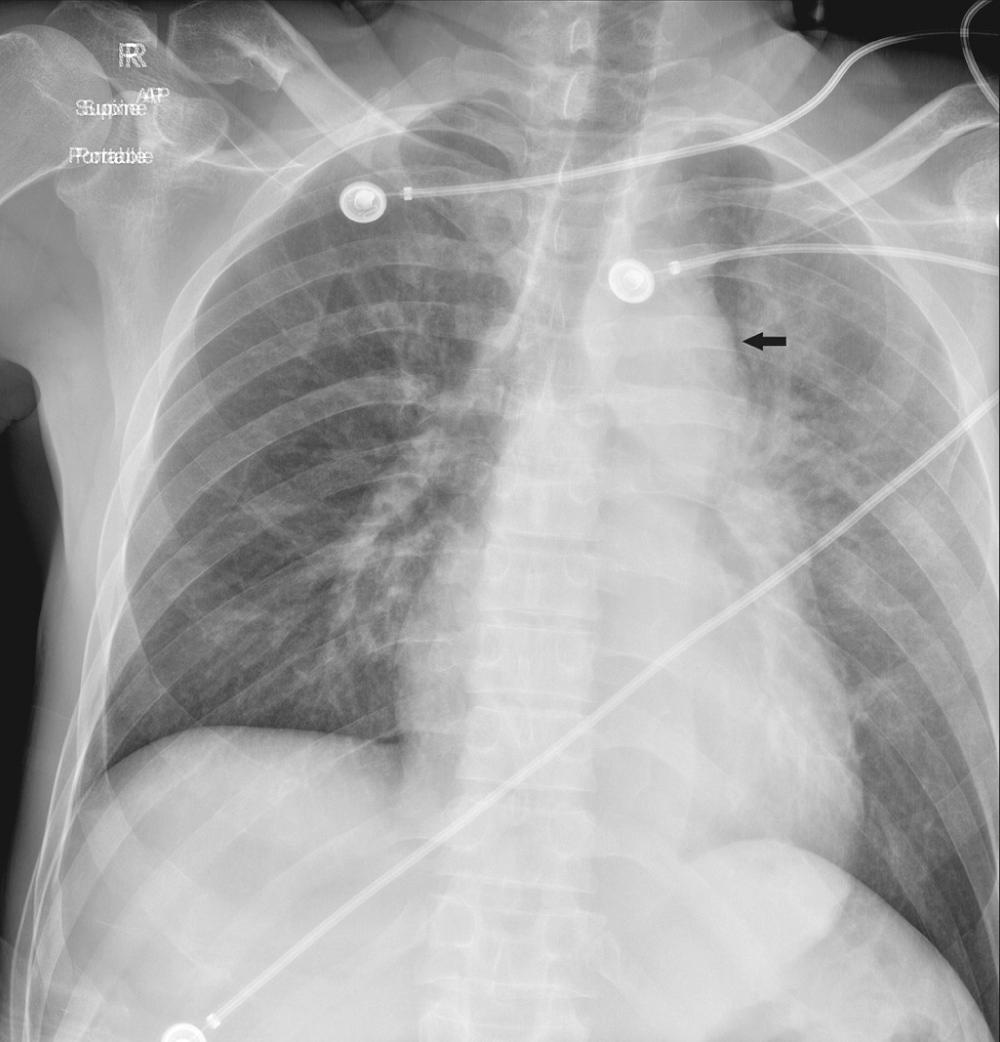
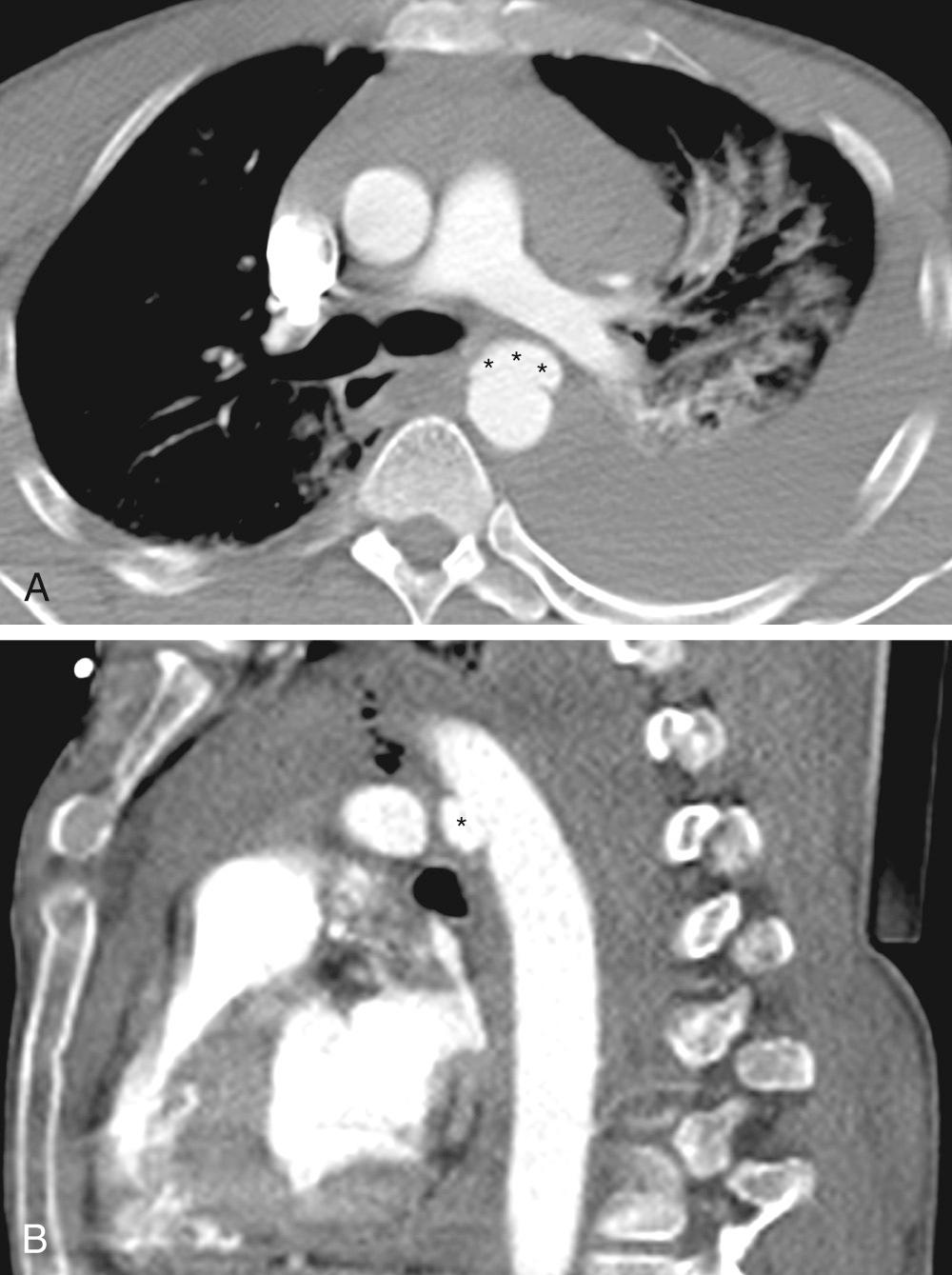
Tracheal and esophageal injuries are uncommon but are typically found after intubation, a motor vehicle crash, or penetrating trauma ( Fig. 2-4 ). Many of these injuries are not recognized initially because of subtle or nonspecific clinical and radiologic findings. Delayed or missed diagnosis can result in death or severe complications, such as ventilatory failure, mediastinitis, sepsis, airway stenosis, bronchiectasis, recurrent pulmonary infections, and permanent pulmonary function impairment.
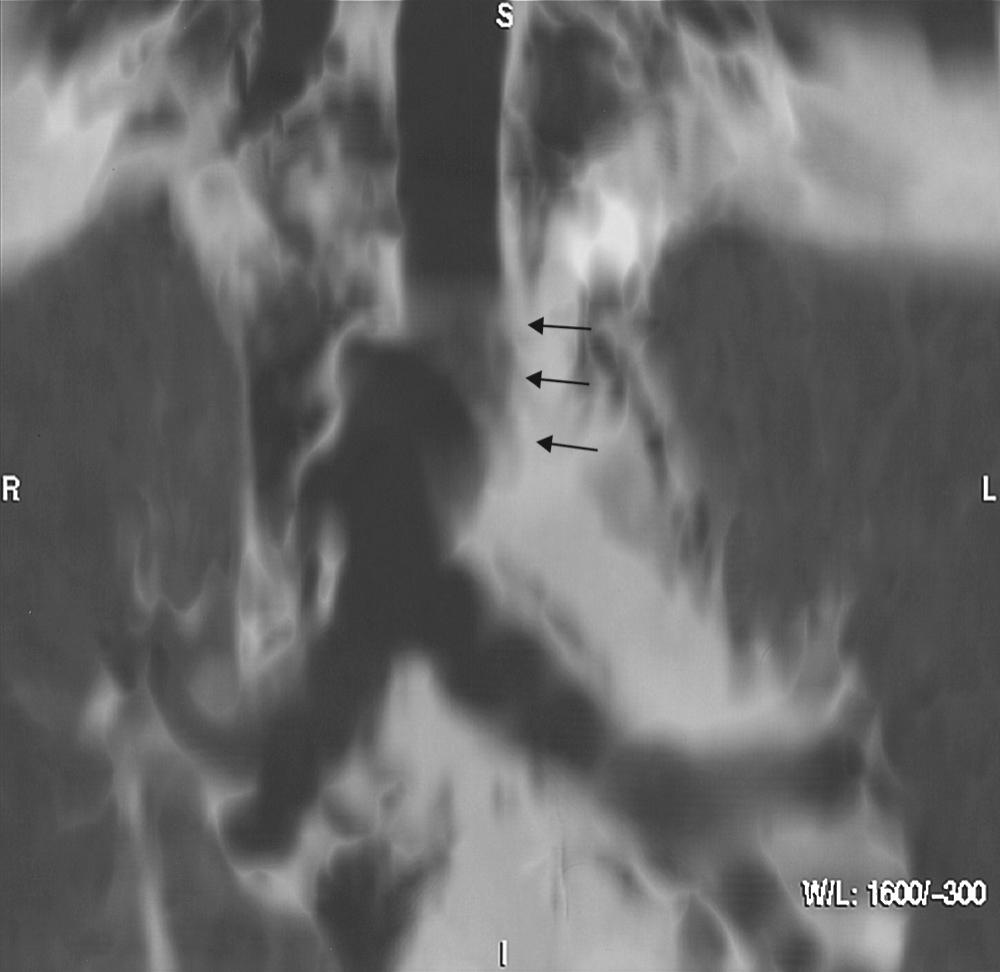
Injuries to the trachea or bronchi can be difficult to diagnose, because patients can have no clinical findings and the radiograph can be normal in up to 10%. In addition, the radiographic findings of tracheobronchial and esophageal injury are nonspecific and can include pneumomediastinum, pneumothorax, and progressive subcutaneous emphysema. However, diagnosis of these injuries is important because there is a high association with esophageal and major vascular injuries. MDCT with multiplanar reconstructions is the imaging modality of choice for visualization of the airways. MDCT has a sensitivity of 85% for the detection of tracheal injuries. Patients with tracheal rupture characteristically have an abnormal air collection in the thorax, and air can occasionally be demonstrated in the soft tissues of the neck. Success in visualizing the tracheal injury ranges from 71% to 94%, and multiplanar reconstructions can be useful in localizing and defining the extent of injury. MDCT also provides information about the esophagus, although if pneumomediastinum, with or without mediastinal fluid is present on chest radiographs or CT after trauma, fluoroscopic esophagography or endoscopy is usually warranted to exclude an esophageal tear. However, recently it has been reported that the high sensitivity and negative predictive value of CT in patients with pneumomediastinum being evaluated for esophageal perforation after trauma negates performing fluoroscopic esophagography.
Focal or diffuse lesions of the central airways are produced by a variety of diseases, including infection, malignancy, trauma, aspiration, collagen vascular disease, and idiopathic entities such as sarcoidosis or amyloidosis. Although patients might have significant symptoms, airway abnormalities are frequently not apparent or are overlooked on the chest radiograph. If there is a clinical suspicion of a tracheobronchial abnormality, further evaluation by CT is warranted. MDCT using thin slices (1 to 3 mm) is preferred, as it produces excellent axial and multiplanar images, including virtual bronchoscopy, that allow complex tracheobronchial anatomy to be visualized, depicting even weblike stenosis that can easily be missed or underestimated with thicker sections ( Fig. 2-5 ). MDCT performed during dynamic exhalation is also useful in demonstrating the excessive tracheal collapse that can occur because of either weakness of the supporting tracheal cartilaginous structures (tracheomalacia) or from excessive anterior bulging of the posterior membranous wall of the trachea (excessive dynamic airway collapse). These related disorders are a potentially underdiagnosed cause of chronic respiratory symptoms.
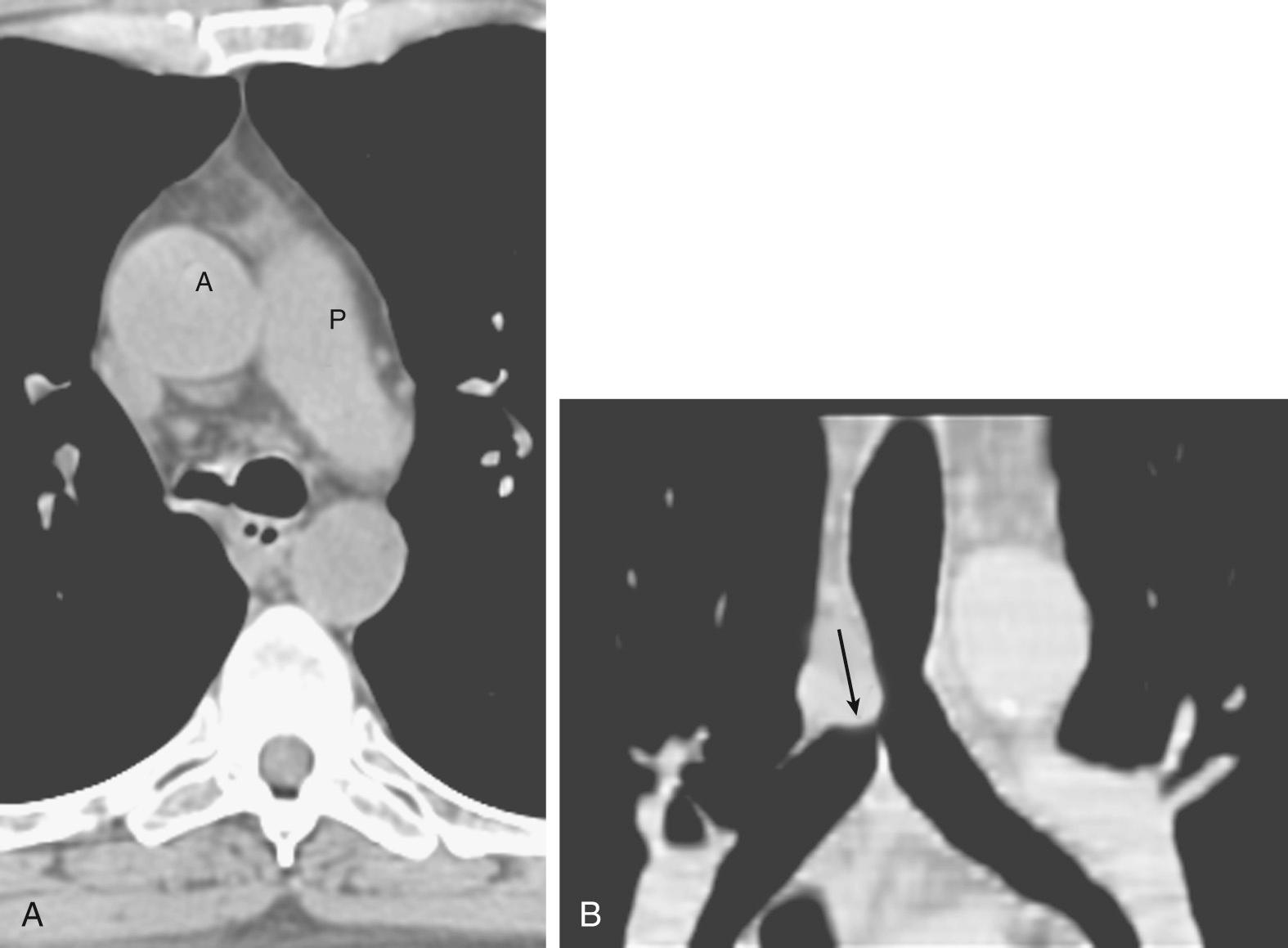
Become a Clinical Tree membership for Full access and enjoy Unlimited articles
If you are a member. Log in here